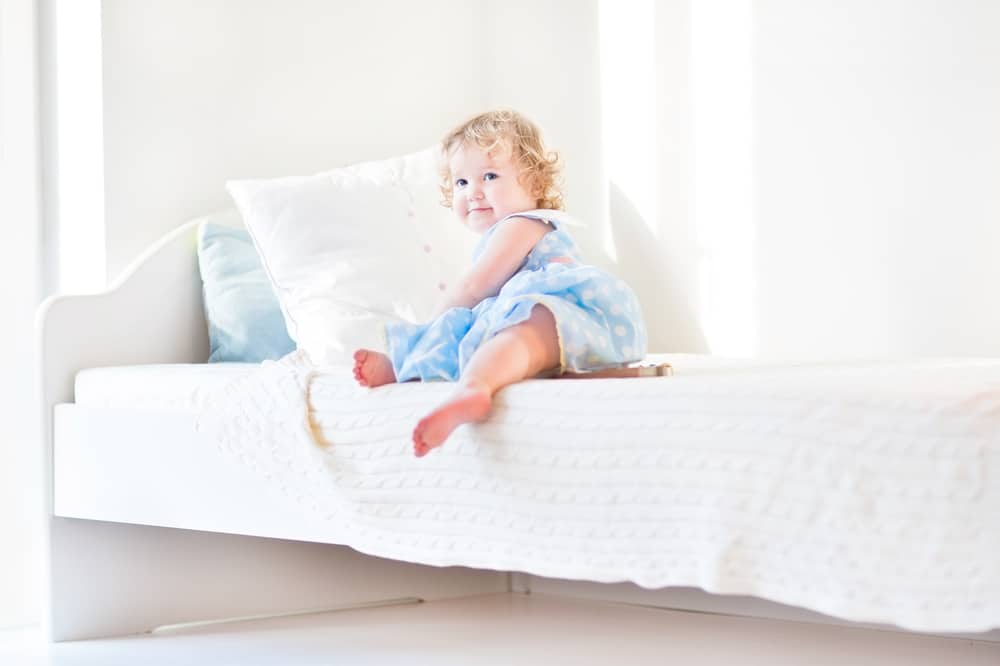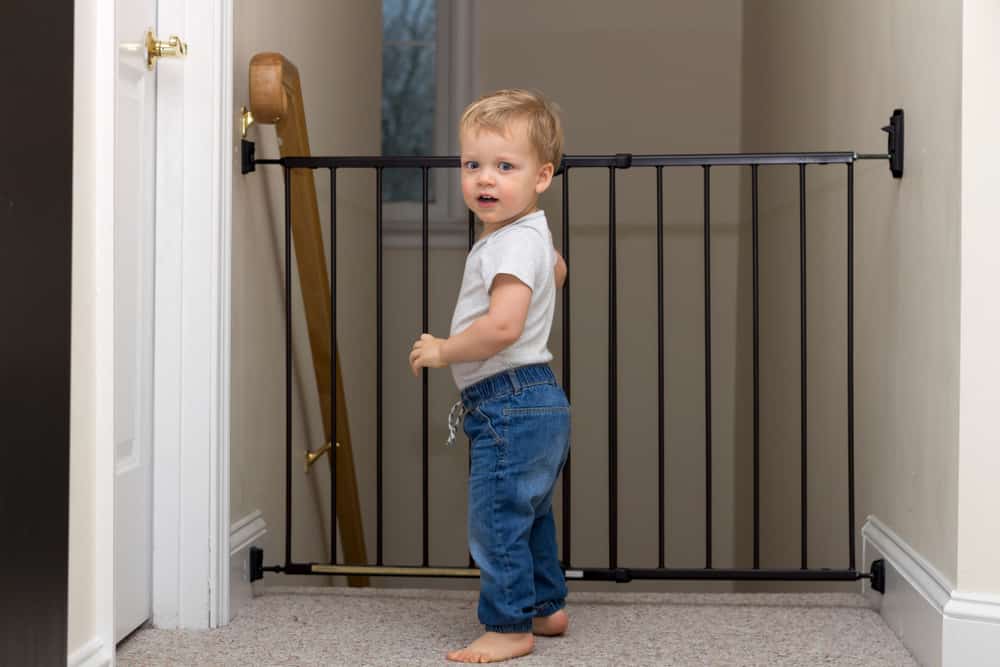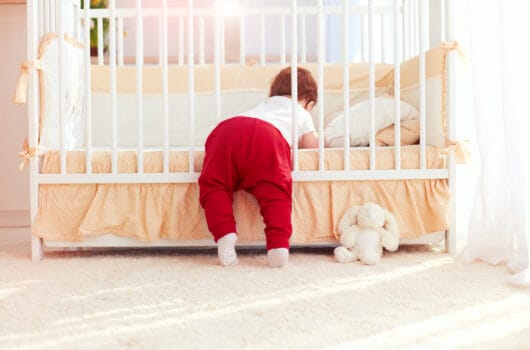So what’s the best way to know when your child is ready to make the switch from a crib to a toddler bed? More than likely, they’ll be sending the message to you all on their own. You may have begun to notice that your child has made repeated attempts to escape their crib, or maybe they’ve even expressed it to you verbally.
When it comes down to it, there really isn’t a set age at which you’re expected to begin transitioning your child over from a crib to a toddler bed. In most cases, a child will be ready to switch over to a toddler bed anywhere between the ages of 18 months and 3 ½ years.
Keep in mind, the timing may vary, as each child’s developmental stages may be slightly different. Generally speaking, if your child has reached 3 feet in height, made repeated attempts to climb out of the crib, or verbally asked about having a big-kid bed, then it’s probably time to transition them over to a toddler bed.

Choosing The Right Toddler Bed
There are a few different options when it comes to choosing a toddler bed. The option you choose will come down to personal preference (between you and your child), budget, or convenience. The first option is to purchase a toddler bed that is essentially a smaller version of a twin-sized bed. For these, there are fun options for you and your child to choose from (race cars, fire trucks, princess castles, etc.). These options are also a great way to make it fun if you have a child that is reluctant to transition to a toddler bed, even though it’s time.
The next option you have for toddler beds is an actual twin-sized bed that is fitted with safety rails. This is a great option for parents whose child has expressed a strong interest in upgrading to a toddler bed but are concerned that they may be slightly ahead of schedule. The safety rails give you peace of mind knowing that there is an extra layer of protection for your child, just in case they are not quite ready.
The final option is a crib that actually converts into a toddler bed. If you invested in one of these beds for your child, you will not have to go out and purchase a new toddler bed. This is a great budget option since the bed evolves with you as the child grows and therefore, the life of the product is extended. No matter which of these options you choose to go with, there are a few safety measures that you’ll want to keep in mind as you search the market for a toddler bed that’s best for your child:
Sturdiness
The most important thing is that the toddler bed you choose is sturdy enough to support your child. Children love to bounce around, roll, and jump, so the bed you choose needs to be able to take a beating from them over time.
Safety Railings
As we mentioned before, choosing a toddler bed that comes equipped with safety rails will help to add an extra layer of protection for any child, but especially those that seem to be developing ahead of schedule and want to sleep in a big-kid bed. These beds allow you to have peace of mind knowing that even if your child rolls around in their sleep, they’ll be prevented from falling off of the bed, thanks to the safety rails.
Proper Height
If you decide to go with a toddler bed option that doesn’t have safety railings, then it’s important to make sure that the bed is the right height for your child. It needs to be low to the ground so that in the event that your child does roll out of the bed, the chance of injuries is limited. Having a lower bed also makes it easier for your child to get in and out of the bed safely on their own.
Certification
An extra step you can take is to make sure that the toddler bed you plan to purchase has been certified by the Juvenile Products Manufacturers Association (JPMA). There should be a sticker placed somewhere on the bed that displays this certification, which shows you that the product has been verified by the association and is certified to be safe and within their product safety guidelines and criteria.
Simple and Efficient
This is another safety measure that will help keep your child safe in their new bed—aim for a toddler bed that has a smooth finish with limited ornamentation, or protrusive designs. This will minimize injuries like accidental bumps or bruises. It’s also beneficial to go for a toddler bed-mattress combo if possible, that way you’ll be sure that the mattress will be a perfect fit.
Safety Measures
Now that we’ve gone over the options available for toddler beds, it’s important to take a look at some additional measures besides the bed, that will help create a safe space for your child to sleep in.

The first thing you’ll want to do is choose the right spot in the room for the bed. This may be a different area than where the crib initially was. You’ll want to position the bed away from things that could present a possible danger to the child, such as curtains, radiators, floor lamps, or blind cords.
Next, be sure that the headboard is placed flush up against the wall so that there is no space behind it. Also, be sure to leave enough space on either side of the bed so that there’s less of a chance the child could get trapped between the bed and the wall. If you are going with a toddler bed that is equipped with railings this shouldn’t be an issue.
The floor space around the bed will need to be safe for the child as well. If you live in a home with hardwood floors or any other type of flooring besides carpet, you’ll definitely want to have a soft rug placed down around the bed in order to cushion any possible falls. Placing pillows down near the bed may work as well.
Finally, upon finishing the installation of the toddler bed, be sure to check that all screws, joints, and other features are securely in place to prevent choking hazards or collapses. It’s also a great idea to check on the security of all screws and joints periodically to make sure the bed is still holding up well over time, especially if your child tends to jump around and play on the bed frequently.
There are many other helpful safety tips that can help prepare your child to transition safely to a new toddler bed. Taking these precautions can help prevent injuries and help you create a safer space for your child to sleep.
Tips to Ease Transitioning From a Crib to a Toddler Bed
There are many other things you can do to make the transition from a crib to a toddler bed as smooth as possible for both you and your child. Let’s go over some of them:
Take It Slowly
Make sure that your child has either expressed interest with you in moving up to a big-kid bed or they’re nearing 3 years of age. You never want to rush the process and turn the event into something that is overwhelming or scary for the child.
Do the Research
It’s good to know as much as you can about transitioning to the toddler bed, but it’s also good that your child knows what to expect as well. Be sure to sit and have a talk with your child so they know what to expect before switching them over to the new bed.
Make Use of a Convertible
If you’re considering your options ahead of time, you might have already stumbled across and toyed with the idea of purchasing a convertible crib for your child. These options tend to work well at making the transition much less stressful for you and your child since the change isn’t as drastic. These beds usually have a removable front panel that turns the bed into a toddler bed easily.
Have Your Child Participate
The more involved your child is in the process, the easier it will be for them to make the transition and understand what is going on. Some tips to get them involved are to have them choose their new sheets, or pick out a new stuffed animal or two to bring with them to the new big-kid bed.
Child-Proof the House
You may already have this one covered, but with transitioning your child to a toddler bed, there is the new risk of them being able to now leave their bed in the middle of the night while you’re asleep. To prevent any injuries, consider blocking off any stairwells or rooms you wouldn’t want them to enter in the middle of the night alone. Also, be sure to put away any hazardous items such as cleaning materials or medications.
Keep Things Familiar
In order to not make it such a drastic change for your child, try to keep things as familiar as possible. If you can, build the new toddler bed in the same spot as the original crib. Try keeping the child’s bedtime the same as well. Even though they’re getting older and moving up to a big-kid bed, they still need plenty of sleep and a regular sleep schedule. This decreases stress for the child as well.
Make It Rewarding
Be sure to give plenty of praise to your child for adjusting well to the new changes. Rewards also help to encourage good behavior, such as staying in bed throughout the night and sticking to their scheduled bedtime. You can keep track of this and create a visual for the child by placing a sticker chart on the wall. Each night they are successful at sticking to the bedtime rules, they receive a sticker. At the end of the week, reward them for all of their hard work with a special treat or family outing.
Patience, Patience, Patience
Transitioning your child from a crib to a toddler bed can be an ordeal, even for the most prepared parents. It’s best to mentally prepare for some of the things that are likely to happen and to understand that these are a normal part of the process for most people. You may find that your child may love to climb out of their new bed in the middle of the night to come to sleep in bed with you or to ask you for a glass of water or a snack. If this happens, calmly and quietly walk them back to their room. Don’t make a scene, just carefully show the child this is not the right thing to do. If all else fails, you could consider putting one of the baby gates at the door to their room to create more of an obstacle and discourage nighttime wandering.
Keep the Crib
Finally, hang on to the crib if you can, even after purchasing the new bed. You never know if your child may have expressed interest too soon or isn’t quite ready to make the transition as originally expected. If you feel as though your child may have expressed interest too early on and isn’t quite ready or is having trouble adjusting to the new bed, it’s okay to have your child return to sleeping in it temporarily, until a more appropriate time. Above all else, have patience and enjoy this important transition for your child.
Wrapping up
Although these tips and tricks can help make the transition from a crib to a toddler bed a lot smoother, it’s important to keep in mind that you shouldn’t expect a completely effortless transition. It’s possible that your child may be completely resistant to the idea of having a new bed and prefer to stay in his or her crib. The best thing to do in this case is to stay positive and continue to encourage your child to see the benefits of sleeping in their new bed, even if it takes a month or two for them to fully adjust.
